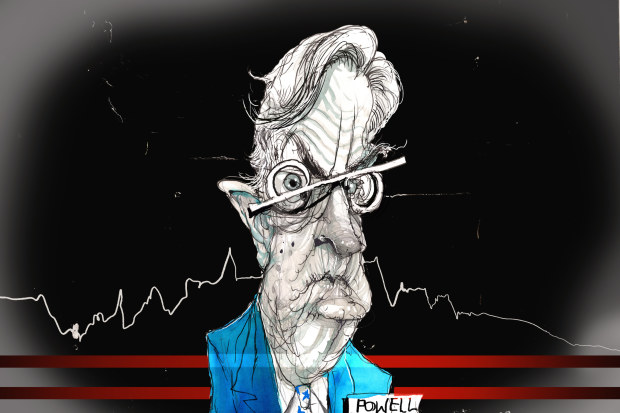Chanticleer

What really matters for investors now Fed rate cuts are a certainty
After the US central bank signalled rates will fall, Wall Street is at or close to record highs – it’s as if the many increases never happened. But what comes next?
What a difference two weeks makes.
Following the biggest November rally for 40 years on Wall Street, US Federal Reserve chairman Jerome Powell started December by trying to talk tough.
“It would be premature to conclude with confidence that we have achieved a sufficiently restrictive stance, or to speculate on when policy might ease,” he said on December 1.

US Federal Reserve chairman Jerome Powell: Let the pivot party begin. David Rowe
But on Wednesday night, after the Fed kept rates on hold at 5.25 per cent as expected, Powell’s hawkishness was gone.
While he went through the motions in his post-decision press conference – the job on inflation is not done, blah, blah, blah – there was no ignoring the elephant in the room. The Fed’s forecasts for rate cut movements next year (contained in the infamous “dot plot”) showed 75 basis points of cuts. Five Fed members expect 100 basis points of reductions.
For financial markets that have rallied hard on the expectation the Fed will start cutting as early as March, and bring rates down to about 3.75 per cent by the end of calendar 2024, this was manna from heaven.
The S&P 500, the global proxy for risk, surged as it became clear Powell wouldn’t push back against the market pricing in rate cuts, jumping as much as 1.4 per cent to take gains from the end of October to 14 per cent.
The Nasdaq was up 1 per cent on Wednesday night. The time-honoured Dow Jones Industrial Average rose 1.2 per cent to a record high.
Soft landing bets
These are impressive daily moves, but we should take a moment to recognise that what has happened on financial markets in the past month and a bit is extraordinary.
The S&P 500 is now just 1.4 per cent away from the all-time high it hit in January 2021, at the peak of the pandemic frothiness and before the Fed began the fastest tightening cycle in a generation.
Or as Nick Ferres, chief investment officer at macro fund Vantage Point, puts it: “It is as though the Fed’s tightening cycle had never happened.”
The ASX 200 joined in the pivot party on Thursday, surging 1.6 per cent to a five-month high. The rally on the local bourse has been more muted than in the US, given the Reserve Bank is a little further behind in its inflation fight. Nevertheless, the near 9 per cent gain since the end of October is clearly impressive; with six trading days until Christmas, we are looking at a gain for 2023 of more than 6 per cent.
Oh, and the index is just 3.4 per cent off its all-time highs.
After this stunning rally, do stocks still offer enough reward for the level of risk out there?
The belief in the soft landing scenario – that sticky inflation, particularly in services, can continue to fall gently, that the labour market softens, but not too much, that the US and global economy can avoid recession – is clearly strong.
And if you listen to Powell, that’s completely reasonable. As he said, restrictive rates have allowed good progress to be made on inflation, the labour market is strong, but not as hot as it was, and for now at least, the long-predicted recession remains just that.
Not even the most bearish commentator could deny that this is a pretty good picture. But now investors need to consider an important question: can this rally continue to run, or is the Powell pivot priced in?
Ferres notes that not only are sharemarkets at or near record levels, but measures of risk perception have also plummeted, with volatility back at levels last seen in 2019, and measures of equity risk premium (including the difference between earnings yield on equities and the 10-year Treasury yield) back at levels not seen in two decades.
Investors betting the rally can keep running need to get their heads around a few factors, Ferres argues.
First, they need to recognise that it “would be unusual for a new bull market to commence before the impact of the recession on the labour market and the default cycle in credit has even commenced”.
Second, they need to recognise that the risk/reward equation for US equities is “extremely unattractive” unless earnings pick up or there is a meaningful fall in interest rates.
But Ferres says economic data, which points to economic and labour market softening, does not exactly support a strong recovery in earnings. And while rates are coming down, a big fall would occur as economic growth is weakening, which isn’t traditionally supportive for share prices.
By banking on a soft landing, investors may also ignore the potential for US growth to either fall faster and cause a hard landing, or remain resilient, creating a sort of no-landing scenario, where the anticipated rate cuts don’t come at all, and inflation accelerates.
But that’s next year’s problem. The question that matters right now is this: after this stunning rally, do stocks still offer enough reward for the level of risk out there?
Introducing your Newsfeed
Follow the topics, people and companies that matter to you.
Find out moreRead More
Latest In Equity markets
Fetching latest articles